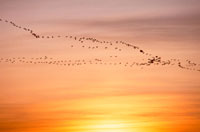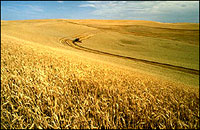You’ll have to forgive the staid title: Right from the start, The Farm as Natural Habitat: Reconnecting Food Systems with Ecosystems is thoroughly Midwestern in tone — reserved, practical, and down-to-earth. Edited by long-time sustainable-agriculture advocates Dana and Laura Jackson, a mother-daughter team, the essays collected here describe farming practices that mimic and protect natural systems. But if the voice is mild, the message is urgent: Environmentalists must build ties with farmers if we are to grow food without destroying topsoil, poisoning our air and water, and killing wildlife.

The Farm as Natural
Habitat By Dana and
Laura Jackson Island
Press, 250 pages, 2002
The Farm as Natural Habitat begins by noting that the American Midwest is too often abandoned as our national “ecological sacrifice area.” Environmentalists have ignored agricultural lands, write the Jacksons, because they believe that nature is found in parks, not on farms in square states whose names begin with vowels — or perhaps because they have bought into the notion that industrial agriculture is a necessary evil if we are to have enough food to eat. But there is no need to sacrifice the nation’s heartland to feed its people: As Laura Jackson writes in “Restoring Prairie Processes to Farmlands,” “There is a good deal of territory in between ‘wilderness’ and ‘agricultural wasteland.'”
Many of the essays in this book call on environmentalists and farmers to embrace the idea that nature is more than a product. A product-based strategy for integrating farms and natural habitats might entail building wetlands and planting native prairie patches. That’s an important contribution, of course — but the agro-ecological restoration illustrated in these essays goes deeper than that by looking for ways to integrate farming practices with natural processes.

Not just flights of fancy.
Photo: USFWS.
For example, if nature is not just a product but a process — say, the way water and migratory birds move across a landscape — farmers can integrate those processes into their agricultural practices. That’s what South Dakota farmer Dennis Fagerland does every spring when he builds a series of culverts to create temporary wetland nesting habitat for ducks. The wetlands also decrease the flow of nitrates from his farm to a nearby lake. In “Stewards of the Wild,” Brian De Vore describes how the practice also has economic benefits: When Fagerland opens the floodgates in mid-June, he’s left with a rich stand of slough grass that produces triple the region’s average hay crop per acre.
Most often, nature is both product and practice, and farmers can sometimes successfully mimic both. For instance, if nature is charismatic megafauna and the natural disturbances created by their grazing patterns, cows can sometimes do the ecosystem work of buffalo and elk, as De Vore describes in “When Farmers Shut off the Machinery.” One farmer followed the standard recommendation to fence off a portion of a stream to keep his cattle from grazing on the bank. The results were unexpected: “The fenced-off area, now heavily forested, is host to a wide, shallow stream with erosion-prone banks. It’s almost impossible to wade through the sunless stretch because of the mucked up bottom. The trees have grown so well that they’ve shaded out the grasses and other undergrowth that hold soil together.” By contrast, “the section right above the fenced-off area, where [the farmer] retarded succession by allowing cattle to periodically graze, is a scene right out of a trout angler’s dream.” Under certain circumstances, controlled grazing of cows can mimic the effect of migrating herds of wild mammals, breaking down the angle of a sharp stream bank and creating a nutrient-rich environment where new plants can grow.

Wheat’s up?
Photo: USDA.
Although sustainable agricultural practices on individual farms are essential to environmental health, they can’t be effective in isolation, and the book also documents a half-dozen successful partnerships among government agencies, environmental groups, and private landowners to encourage eco-agriculture. For example, in “Reading the Land Together,” the executive director of the Aldo Leopold Foundation describes the Blufflands Project, which assists nearly 40 private landowners in conducting prescribed burns, controlling invasive species, and restoring prairies on more than 1,000 acres of former savannah in the lower Wisconsin River Valley.
One of the book’s most inspiring stories of farmers and environmentalists working together to “have their cake and nature, too” describes a partnership in the wheat-growing region of Minnesota’s Red River Valley. Farmers, conservationists, state and federal water and wildlife agencies, and municipal government agencies met with a mediator to create workable solutions to the problems caused by a decade of flooding in the valley. Cheryl Miller, who represents the National Audubon Society in the ongoing negotiation process, writes in “After the Deluge,” that the group consensus plan includes protecting farmers and restoring the natural characteristics and functions of the region’s rivers and lakes, restoring prairies and wetlands, and protecting native species. Miller concludes, “Environmentalists need to learn how to ‘get on the same side of the table’ as farmers and others struggling with a variety of environmental problems and cooperate in working through the social and institutional factors that drive environmental degradation.”
Environmentalists may not want or need to know as many specifics about agricultural management practices as this book provides. Yet the detailed stories are worthwhile, because they collectively illustrate one of the basic maxims of the environmental movement: Everything on Earth is interconnected. They also add up to a nuanced understanding that ecosystem processes (such as water management and nutrient cycling) can be as important as ecosystem products (such as native species). Perhaps most important, the stories of positive, complex, long-term interactions among farmers, environmental groups, and government are an excellent resource for thinking about how to develop new coalitions to better protect the environment. Environmentalists have already begun to “get on the same side of the table” with labor, the religious community, and some businesses. The Farm as Natural Habitat demonstrates that we must also build such coalitions with agriculture.



